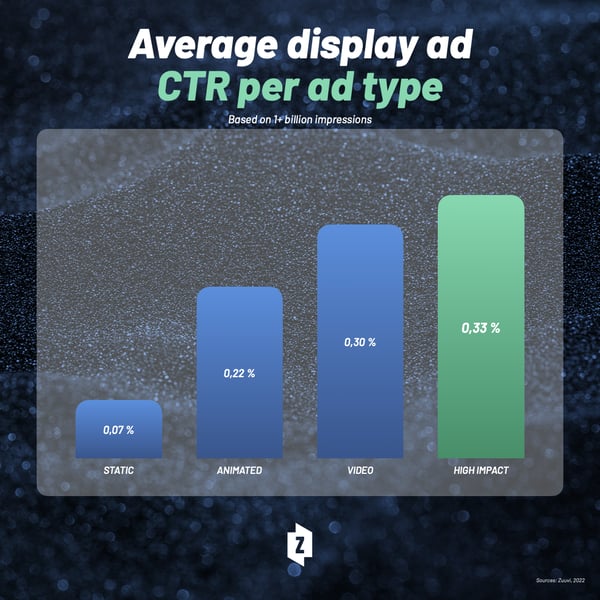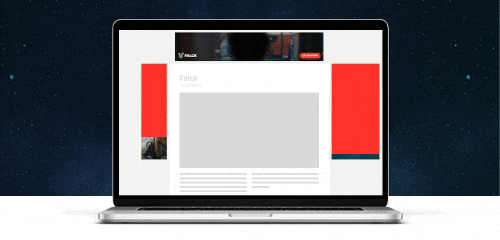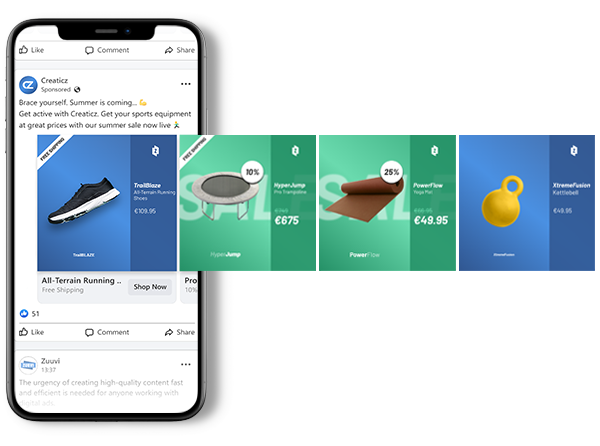What is Creative Freshness?
Now that we're well into 2025, it’s time to take stock of the AI-dominated rollercoaster of 2024 has been, and understand how the display advertising landscape is shaping up in the next months.
In this article, we’ll take a look at the 6 biggest trends in display advertising. From the rise of video ad content as a sure-fire way to boost CTR, to the rollout of the 5G network and the impact it will have on your ads and their visibility, we will take an industry-wide perspective on display advertising and make predictions on its future for 2025 and beyond.
We promise you will find at least one interesting trend for you, regardless of your area of advertising expertise: buckle up!
1. The rise of video ads
Video ads have taken the digital advertising world by storm. Despite longer production times, higher costs, and, generally speaking, slower load times, video ads outperform their static counterparts in terms of CTR, engagement, brand recall, and purchase intent.
And that’s hardly surprising. One of the key advantages of video advertising is its ability to capture attention and evoke strong emotional responses. By combining compelling visuals, music, and storytelling, advertisers can create a powerful connection with their audience.
We have tested this trend ourselves. After having tracked over 1bn impressions across all our users, the result was clear: video ads had a 4x better performance than static ads.

Right now, the question is not whether you should create video ads, but rather, how you can create them faster, cheaper, and better. The surge in HTML5 ads is providing an answer to most of these issues.
HTML5 ads allow you to load up heavy ads with no web page load speed issues, and given they are based on code, HTML5 ads are compatible with pretty much every operating system or browser.

Bonus tip:
While HTML5 is the language that powers interactive ads, you don't need coding expertise to create captivating HTML5 ads. Creative design platforms have changed the rule of engagement, making HTML5 ads accessible to anyone with a flair for creativity.
At Zuuvi, for example, the coding happens in the backend, and what you design occurs in the front end.
That means, you will create the HTML5 ads in our drag-and-drop editor while using videos, images, audio, or illustrations to create a professional-looking ad in just a few minutes.
2. When you go still, focus on dynamic ads
But if video is not an option? What if you are, let’s say, a retail business with whole product catalogues to promote?
There’s still a lot you can do with your static ads. With Dynamic Content Optimisation or Dynamic Product Ads, you can produce 100s of high-quality, high-engagement ads at speed, without having to deal with the quality v. quantity tradeoff.
With dynamic ads, advertisers use consumer data to implement creative elements that appeal to the audience better. Creatives can vary by ad but usually include a combination of copy, visuals and the products featured.
There are many reasons to invest in dynamic creatives. Creative display ads integrate better into various social media platforms. Dynamic creatives perform a lot better than traditional product ads too! According to the industry average, dynamic product ads perform, on average, between 50% and 90% better than traditional static ads.

Dynamic creatives are extremely easy to make too! All you need is a solid template, your product features (usually stored in a spreadsheet), and a creative design platform with integrated automation features.
After you have “fed” your product features to the platform and created your template, you will be able to build 100s of product ads in minutes.
3. Graphic design trends in 2025
Let’s take a break from technological advances, and focus on the actual design of your creatives and what’s trending at the moment.
What’s the word from the street? Minimalism…with a twist. Graphic design trends in 2025 are all about embracing vivid and fluorescent colour palettes in minimalistic designs, creating a sharp-looking visual feast for the eyes.
Whether it's web design, branding, or print materials, designers are infusing their creations with colours that demand attention and create a lasting impact.
Minimalistic and utilitarian design is also reflected in the use of shapes. Retro-looking shapes, doodles, and the use of pixels to dissolve or add motion to the creatives are being used more and more, without signs of stopping in 2025.
Finally, nostalgic patterns, reminiscing raw, brutalist art movements, have made a comeback. Their simple, sharp look may be perceived as harsh or cold by some, but when done well, they charge your creatives with raw, unfiltered persuasion power.
4. Dominance of mobile advertising
More than a whole new trend, we should probably consider the dominance of mobile advertising as an ever-growing phenomenon that started some years ago. In the age of smartphones, mobile advertising has become the cornerstone of digital marketing strategies.
Mobile advertising allows advertisers to promote their products or services at any time or place. With the ability to target their users contextually (more on that later), advertisers can tailor their creatives based on the users’ location, interest, and browsing habits.
This is contributing to a multi-channel, mobile-first experience that’s getting more and more refined with each passing year.
The rules of the game are changing: if mobile-friendliness was once a nice-to-have, and then a must-have, right now, you gotta shift your marketing perspectives to mobile-first.
The browser is dead, long live the mobile.
5. Contextual advertising
Marketing is all about turning wants into needs. And surefire way to do that is by delivering the right message, at the right time, in the right place - contextual advertising in a nutshell. Contextual advertising is becoming the norm in digital marketing for a number of reasons.
First, it’s easier and more affordable to implement. You don’t need a lot of data, to begin with: you don’t have to rely on complicated—and expensive—behavioural data to know that by placing your running shoe ad in a running blog, you will likely cater to an audience interested in running, and thus more likely to buy.
Next, contextual advertising is safer for brands. Think about it: would you like to display your ad on an extremist website just because one of your potential users navigates there?
With contextual targeting, however, you choose the topics, subtopics, and keywords. And this makes it less likely your ads are going to follow a user to an environment where they don’t expect (or want) to see advertisements, and where you don’t want them showing up.
Last, since it doesn’t rely on behavioural data, contextual advertising is also not constrained by privacy legislation. GDPR is radically shifting digital advertising to the ultimate benefit of the end user, and it’s pushing many advertisers to shift from behavioural to contextual advertising.
6. 5G and higher visibility
Finally, in the age of 5G-enabled programmatic technology, websites load faster, and ad visibility increases.
With faster internet speeds and lower latency, advertisers will have the opportunity to deliver more immersive and interactive experiences, without the risk of users installing ad blockers to speed up their page load (which is, according to Hubspot data, the reason why 36% of all Adblock users install it in the first place).
Moreover, 5G technology will also bring about advancements in location-based advertising. With its improved accuracy and precision, advertisers will be able to target specific geographic areas with their ads.
For example, if you are walking near a shopping mall, you may receive a notification on your phone about a special sale happening inside. This targeted approach will not only benefit advertisers by reaching their desired audience but also benefit consumers by providing them with relevant and timely information.
Tags:
31.12.2025




